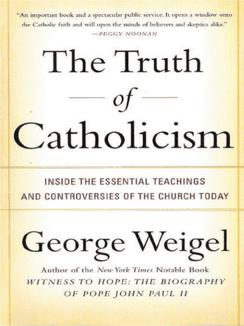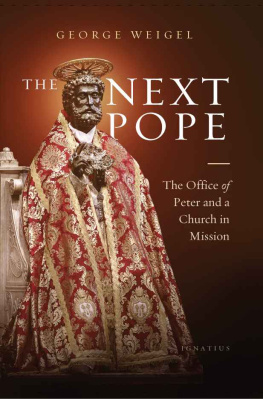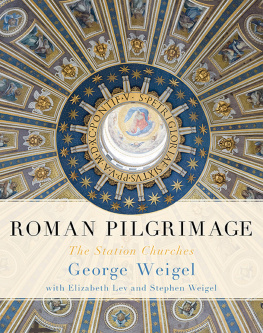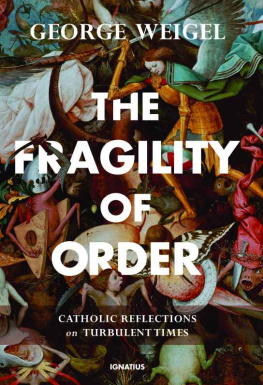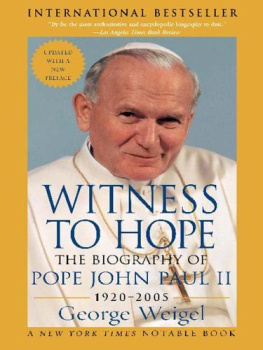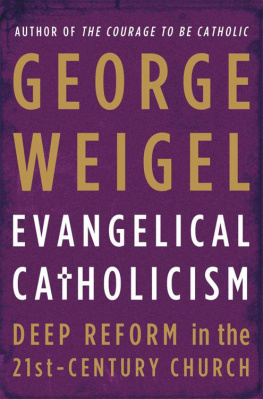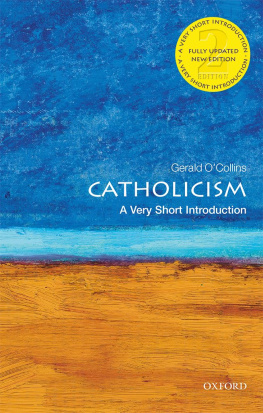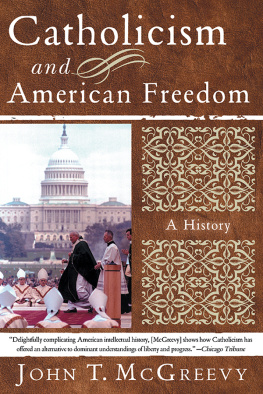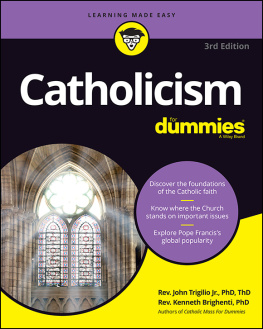
THE TRUTH
OF
CATHOLICISM
INSIDE THE ESSENTIAL TEACHINGS
AND CONTROVERSIES OF THE
CHURCH TODAY
GEORGE WEIGEL

For
the Faculty, Staff, and Students of the
Pontifical North American College in Rome,
19952000
Contents
C HRIST AND THE C ONQUEST OF O UR F EARSL IBERATION AND THE G OD OF A BRAHAM , I SAAC , J ACOB, AND J ESUS
W HY C ATHOLICISM I S N OT A D ENOMINATION, AND W HAT T HAT M EANS
L ITURGY AND THE E XTRAORDINARY O RDINARY
T HE M ORAL L IFE AND THE L AWS T HAT L IBERATE
C ELEBRATING T HE G IFT O F S EX
R EDEEMING T HE W ORLD AND ITS P AIN
O THER C HRISTIANS, OTHER R ELIGIONS
L IVING F REEDOM FOR E XCELLENCE I N P UBLIC
S AINTS AND THE HUMAN F UTURE
An Invitation to
Come Inside
T he great English novelist Evelyn Waugh once described his Catholic life as an endless delighted tour of discovery in the huge territory of which I was made free. Like many other converts, Waugh was eager to share that adventure with others, and his correspondence is full of letters explaining Catholicism to his friends. At the same time, Waughs experience had taught him that it was very difficult to know what the Church is like from outside. To all the curious, whether attracted or disturbed by Catholicisms teaching and the Catholic way of life, Evelyn Waugh offered a simple invitation: Come inside. Have a look at the Catholic Church from inside the convictions that make Catholicism what it is. Walk around in it. See how it feels. Then decide what you think about it.
At the beginning of the third millennium of Christian history, that simple suggestion to come inside can be as inviting as it was when Evelyn Waugh first issued it a half century ago. Or when, nineteen and a half centuries ago, St. Paul proposed much the same thing to those Athenians who worshiped the unknown god ( Acts 17.1634).
The Catholic Church is, arguably, the most controversial institution on the planet; it is certainly the worlds most controversial religious institution. Whether the question is the uniqueness of Christ, the meaning of freedom, the dignity of human life from conception until natural death, or the use and abuse of sex, the Catholic Church often finds itself a Church of contradiction, in opposition to what seems to be the common wisdom of our times. Because of that, the Church is sometimes an object of hatred and scorn, especially for those who think that the Churchs teachings dehumanize or marginalize them.
Even those who concede that religious faith can be good for some people often imagine faith as another lifestyle choice, of no greater consequence than choosing ones car, pet, or favorite restaurant. In these circumstances, the Catholic Churchs steady insistence that faith involves truths, that those truths involve obligations, and that those obligations demand certain choices can be intimidating, even repellent. Viewed from outside, the Catholic Church can seem narrow-minded, crabby, and pinchedthe heckling preacher of an endless string of prohibitions.
Which is very strange, because Catholicism is about affirmation: the affirmation of humanity, and of every individual human life, by a God passionately in love with his creation. So in love, in fact, that he sent his Son into the world for the worlds salvation. But what Catholicism is is often not apparent from outside.
This small book explores ten of the controversies provoked by Catholicism today, from inside the convictions that make those controversies necessary. It is intended for Catholics who are anxious, curious, or unsure about what their Church really teaches and why, and Catholics who want to share their beliefs with friends and family, especially the young. It is equally intended for the many people who find it difficult to reconcile their admiration for certain CatholicsMother Teresa of Calcutta, Pope John Paul II, their next-door neighbor, or their coworkerwith what seem incomprehensible, even cruel, doctrines. By coming inside and seeing how the Catholic vision of the human condition and the human prospect fit together, both the curious and the discontented will, it is hoped, be able to see affirmation and celebration of the human project in Catholicism, not condemnation and mindless prohibition.
The book should be read inside out in another way. Please resist the temptation to jump first to the sexy issues, literally and figuratively. The Catholic Church is far less obsessed with sex than the media is with Catholic teachings about sex. Prior to World Youth Day in Paris in 1997, the press agency of the French bishops commissioned a study that determined that something like 3 percent of Pope John Paul IIs public statements during the previous nineteen years had had something to do with issues of sexual morality. Yet, as the bishops spokesmen pointed out, to read a lot of the world press youd have thought that sex was all the Pope ever talked, or worried, about. The Catholic Church takes sex seriously, far more seriously than the editors of either Playboy or Cosmopolitan . If we want to understand the what and the why of the Catholic sexual ethic, though, we have to engage it within the broader context of Catholic teaching about who we are, about what reality is, and ultimately about who God is. The Bible doesnt begin with the Ten Commandments. It begins with stories of the worlds creation and with Gods affirmation that the world he created is good.
So, pleasecome inside. No one will force you to stay. But once inside, you may find that what seemed cramped and confining is in fact, as Evelyn Waugh suggested, a huge and liberating terrain on which to live a fully human lifeand to prepare for a destiny beyond mundane imagining.
Christ and the Conquest of Our Fears
I n September 2000, the Vaticans Congregation for the Doctrine of the Faith, often described as the successor to the Inquisition, caused a global uproar by issuing a doctrinal declaration, Dominus Iesus [The Lord Jesus], which vigorously reasserted the classic Christian teaching that Jesus Christ is uniquely the savior of the world, for everyone everywhere. The ensuing controversy had some sharp edges.
One American newspaper displayed a photo of Pope John Paul II, arms outstretched, with the caption Were Number One! More soberly but no less inaccurately, another major paper headlined the story Vatican Declares Catholicism Sole Path to Salvation. According to most of the stories and commentaries that followed, the declaration had done serious and perhaps even fatal damage to thirty years of ecumenical and interreligious dialogue. As the common interpretation of Dominus Iesus had it, the Catholic Church was teaching that Catholics had a singular claim on salvation and that non-Catholic Christians were second-class Christians. As for Jews, Muslims, Buddhists, Hindus, and nonbelievers, well...
None of this was, or is, true, but that is not an easy case to make in a climate in which a lot of people are not sure that anything is true. (It depends on what the meaning of the word is is, as a prominent public figure once said.) In fact, Dominus Iesus taught nothing new, substantively. One distinguished Catholic commentator put the case for the defense succinctly: the declaration reiterated the Churchs faith that Jesus is, as he said of himself, the way, the truth, and the life. He is not one way among other ways or one truth among other truths. That faith in Jesus Christ leads to other convictions, also affirmed once again in Dominus Iesus . Because there is one God, who definitively revealed himself in his Son, Jesus Christ, there is one salvation history, centered on Christ. God gives everyone the grace necessary to be saved, including those who have never heard of Jesus Christ. Yet everyone who is saved is saved because of what God did for the world and for humanity in Jesus Christ.

